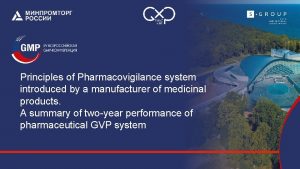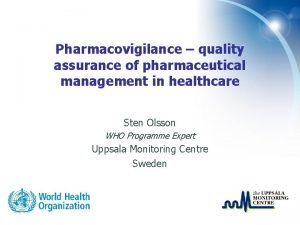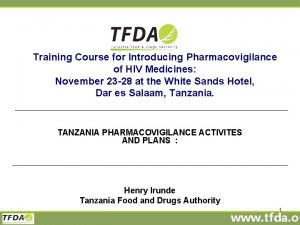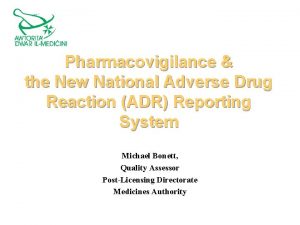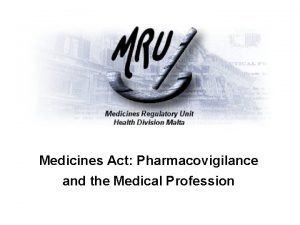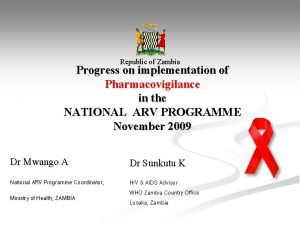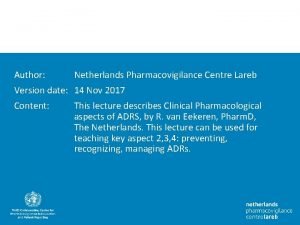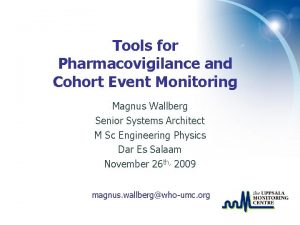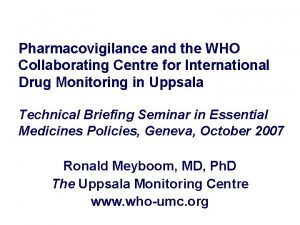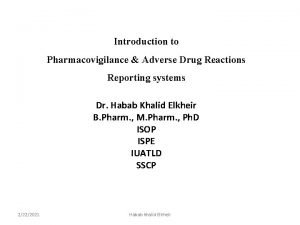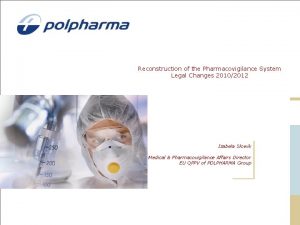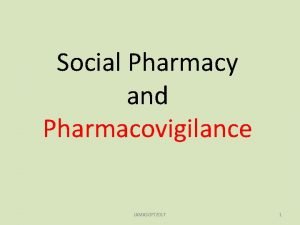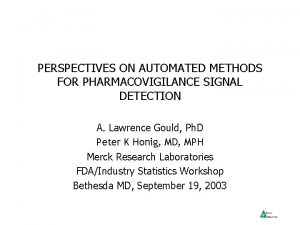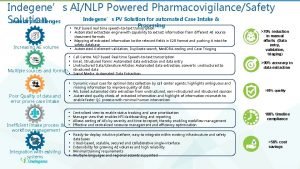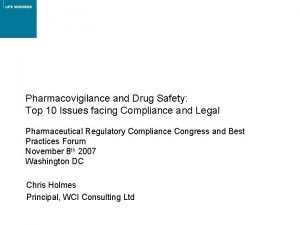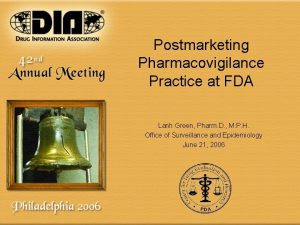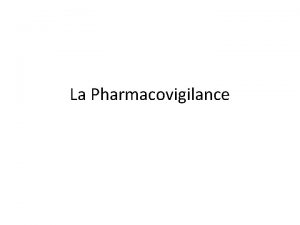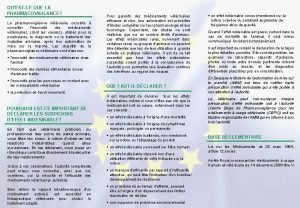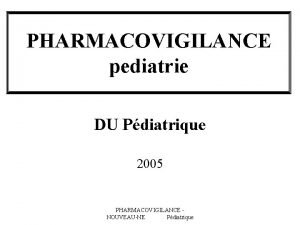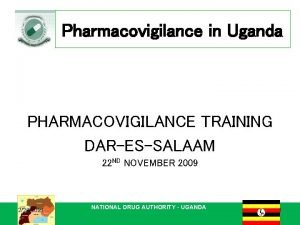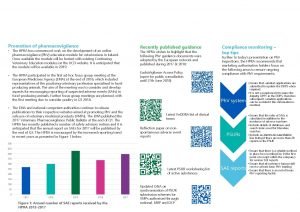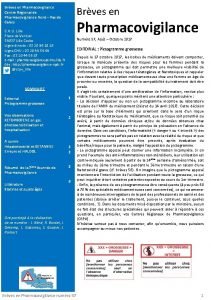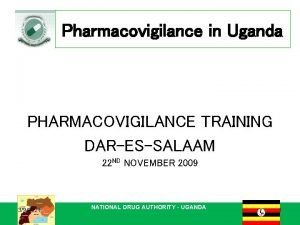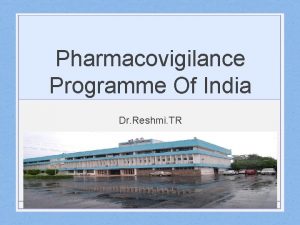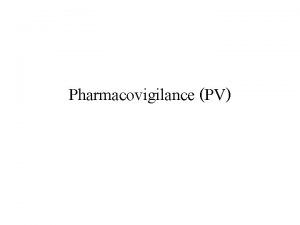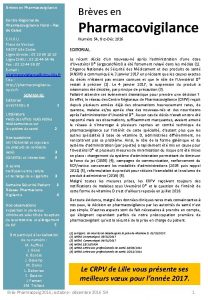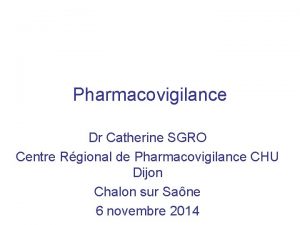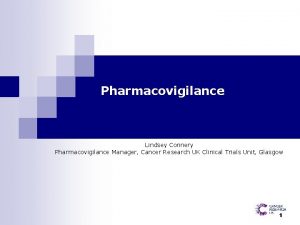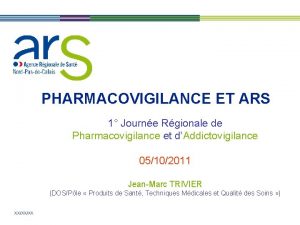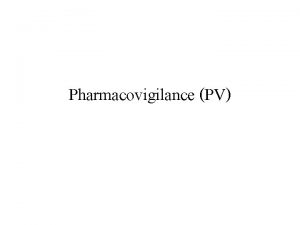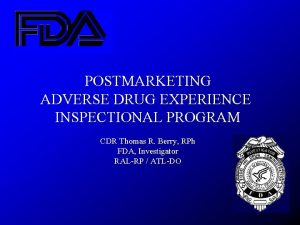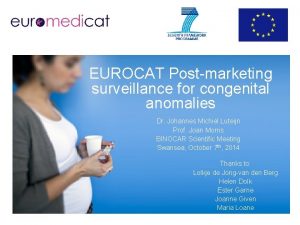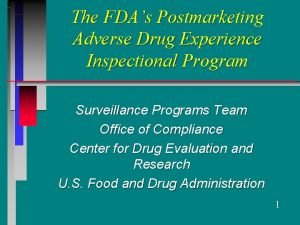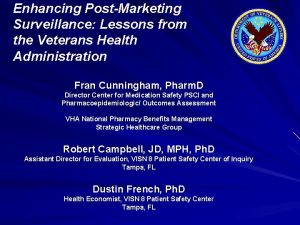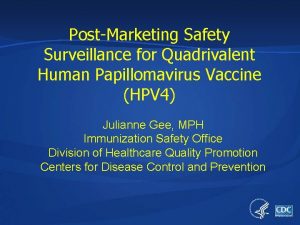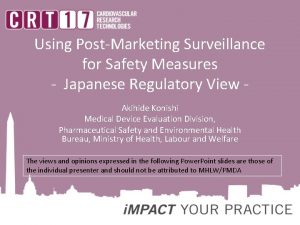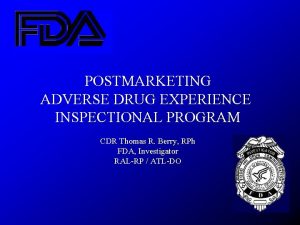Pharmacovigilance in the PostMarketing Setting Results from the










































- Slides: 42

Pharmacovigilance in the Post-Marketing Setting: Results from the RADAR Project Charles L. Bennett MD Ph. D MPP

Barriers to Identifying Adverse Events n Limited size of clinical trials n Undetected toxicities at time of FDA approval n Many AEs identified after several years on the market

Presentation Overview n Comparison of post-marketing pharmacovigilance activities by: – Academic organizations – The Food and Drug Administration (FDA) – Pharmaceutical manufacturers

Objectives n Describe 3 types of pharmacovigilance methods n Illustrate strengths/weaknesses of each approach n Suggest novel collaborations and possibility for new public-private partnerships

Pharmacovigilance Organizations Academic Organizations FDA Pharmaceutical Manufacturers Data Case assessments; Prospective data Med. Watch Proprietary databases Science Pathology; histology None Timeliness 1 -2 years post approval 3 years or more 7 -12 years Dissemination Manuscripts; presentations Package inserts Dear Doctor letters Network Broad; international Mostly internal Funding R 01 -based; CERTs Internal Not known

Lessons Learned: The RADAR method n Detect ADR signals n Investigate possible ADR occurrence n Analyze data n Disseminate results Bennett CL, Nebeker JR, Lyons EA, et al. The Research on Adverse Drug Events and Reports (RADAR) Project. JAMA 2005, 293: 17, 2131 -40.

Timing and Dissemination

Report Completeness: RADAR vs. FDA History/Physical examination (%) Laboratory/ Radiology (%) Basic science correlative (%) RADAR FDA 92* 45 54 46 34 4 Overall mean completeness *P <. 005 for completeness of RADAR vs. FDA q Includes data from 1998 - 2006. q Includes the drugs: gemtuzumab, clopidogrel, ticlopidine, gemcitabine, sildenafil, tadalafil, amiodarone, paclitaxel or sirolimus coated cardiacstents, epoetin alfa, nevirapine, thalidomide, lenalidomide, MGDF, enoxaparin, and bisphonates. Bennett CL, Nebeker JR, Yarnold PR, et al. Evaluation of Serious Adverse Drug Reactions: A proactive pharmacovigilance program (RADAR) vs. safety activities conducted by the Food and Drug Administration and pharmaceutical manufacturers. Arch Int Med. 2007; 167: 1041 -49.

Report Completeness: RADAR vs. Supplier Incidence Rate Number of reports that contain information Outcome Treatment/ prophylaxis References included in report RADAR Supplier 14/15 6/15 15/15 14/15 3/15 12/15 1/15 q Includes data from 1998 - 2006. q Includes the drugs: gemtuzumab, clopidogrel, ticlopidine, gemcitabine, sildenafil, tadalafil, amiodarone, paclitaxel or sirolimus coated cardiacstents, epoetin alfa, nevirapine, thalidomide, lenalidomide, MGDF, enoxaparin, and bisphonates. Bennett CL, Nebeker JR, Yarnold PR, et al. Evaluation of Serious Adverse Drug Reactions: A proactive pharmacovigilance program (RADAR) vs. safety activities conducted by the Food and Drug Administration and pharmaceutical manufacturers. Arch Int Med. 2007; 167: 1041 -49.

Major RADAR Publications Drug ADR N Publication Sirolimus/paclitaxel coated cardiac stents Thrombotic events 139 JAMA 2007 G-CSF/ GM-CSF Acute myeloid leukemia and myelodisplastic syndrome 16 J Natl Cancer Inst 2007 Epoetin/ darbepoetin Venous thromboembolism Metaanalysis J Natl Cancer Inst 2006 Sirolimus/paclitaxel coated cardiac stents Hypersensitivity reactions 6 J Am Coll Cardiol 2006 Thalidomide/ lenalidomide Venous thromboembolism Metaanalysis JAMA 2006 Epoetin Pure Red-Cell Aplasia 9 N Engl J Med 2004 Clopidogrel Thrombotic thrombocytopenic purpura 13 N Engl J Med 2000 Ticlopidine Thrombotic thrombocytopenic purpura 21 Lancet 1998

Postmarket Pharmacovigilance Hampton, T. Postmarket “Pharmacovigilance” Program on Alert for Adverse Events from Drugs. JAMA, August 22/29 2007, 298 (8): 851 -2.

Example 1: Epoetin and Pure Red-Cell Aplasia Bennett CL, Luminari S, Nissenson AR, et al. Pure red-cell aplasia and epoetin therapy. N Engl J Med 2004; 351: 1403 -8.

Epoetin and Pure Red-Cell Aplasia Bennett CL, Luminari S, Nissenson AR, et al. Pure red-cell aplasia and epoetin therapy. N Engl J Med 2004; 351: 1403 -8.

Pharmacovigilance Chart: Epoetin and PRCA Academic Organizations FDA Pharmaceutical Manufacturers Data 191 cases 81 cases Johnson & Johnson 170 cases Science Antibodies None Each company had its own test Timeliness First case- 1998; Publications- 2002 and 2004 Warning- 2000 Letter- 2000 Dissemination N Engl J Med Letter to N Engl J of Med ; Package insert Dear Doctor letter Network France, Canada, Italy, U. S. Internal advisory groups Advisory groups of European MD’s Funding R 01 Internal

Summary: Epoetin and PRCA n Safety of epoetin improved to normal; sales maintained n Data exchange between different entities was important n Fear of appearing self-serving limited companies’ ability to monitor epoetin safety

Example 2: Clopidogrel/Ticlopidine and TTP

Clopidogrel/Ticlopidine and TTP Ticlopidine Clopidogrel

Thienopyridine-Associated TTP Onset: ADAMTS 13 Deficient versus near normal levels of ADAMTS 13 activity (p>0. 05).

Thienopyridine-Associated TTP Onset: Ticlopidine versus Clopidogrel (p=0. 0016).

Clopidogrel/Ticlopidine and TTP Two suspected pathogenic mechanisms: 1. In TTP patients with near normal ADAMTS 13 levels, the pathopyshiology resembles that of clopidogrel-associated TTP. 1. 2. In TTP patients with deficient ADAMTS 13 levels, the pathophysiology resembles that of ticlopidine-associated TTP.

Comparison of findings for ticlopidine- versus clopidogrel-associated TTP Category Basic Science Ticlopidine*associated TTP Clopidogrel**associated TTP Probable underlying pathophysiology Antibody mediated Microvascular toxicity and endothelial cell microvascular damage endothelial cell damage High molecular weight v. WF identified during the acute TTP phase Yes ADAMTS 13 -deficiency during the acute TTP phase Yes No Functional Ig. G inhibitors to ADAMTS 13 identified during acute phase Yes No *Ticlopidine received its original FDA approval in 1991; current sales are $100, 000. **Clopidogrel received its original FDA approval in 1998; current sales are $5. 6 billion.

Comparison of findings for ticlopidine- versus clopidogrel-associated TTP Category Ticlopidine. Clopidogrelassociated TTP Usual time-period for onset Two to 12 weeks after drug initiation Within two weeks of drug initiation Renal insufficiency Mild to none Severe Thrombocytopenia Severe Mild Survival following plasma exchange > 90%, usually within days of initiation of plasma exchange 70%, often takes several weeks of plasma exchange Survival without plasma exchange 30% 70% Spontaneous relapse Occasional Infrequent Likelihood of relapse occurring with exposure to the other thienopyridine High Low Clinical

Comparison of findings for ticlopidine- versus clopidogrel-associated TTP Category Epidemiologic Ticlopidineassociated TTP Clopidogrelassociated TTP Epidemiologic studies identifying an association of thienopyridine administration with TTP Surveys Case-control studies Estimated incidence (as listed in the package insert) 0. 01% - 0. 02% 0. 0001% Case-control studies Not done Two studies- neither identified a significantly increased risk of TTP with clopidogrel

Comparison of findings for ticlopidine- versus clopidogrel-associated TTP Category Pharmacovigilance Ticlopidineassociated TTP Clopidogrel-associated TTP Number of cases in the first case reports 4 (year= 1991) 2 (year =1999) Number of cases included in the largest reported case series 98 patients (1998) 50 patients (year 2004) Cases identified by surveying interventional cardiology laboratory directors/ directors of plasma exchange centers/case-control epidemiology studies 24 patients/13 patients/2 patients/13 patients/6 patients Time from FDA approval to identification of first cases 0 years (4 cases) 1 year (2 cases) Time from FDA approval to reporting of first case series 7 years (60 cases) 1 year (11 cases) Rank in FDA Med. Watch database in association with drug-associated TTP reports (1998 - 2006) First Second Advisories from the FDA Package insert (1995); Black Box (1998) Package insert warning (2000) “Dear Doctor” warnings frompharmaceutical supplier 1998 2000

Pharmacovigilance Chart: Clopidogrel/Ticlopidine and TTP Academic Organizations FDA Pharmaceutical Manufacturers Data Prospective cases Med. Watch Retrospective casecontrol study Science Antibody test; Plasma test None Not known Timeliness 1 year Used academic data Dissemination N Engl J Med 2000; JACC (in press) Package insert Dear Doctor letter Network International Internal Funding R 01 Internal

Summary: Clopidogrel/Ticlopidine and TTP n Prospective data collection and basic science support were important n Mechanism characterized n Reporting was timely (1 year post approval)

Example 3: Erythropoietin/darbepoetin in cancer n Since 2003, Market-expanding indications explored: – Anemia of cancer – Anemia caused by radiotherapy – Prevention of anemia prior to chemotherapy initiation – Raising hemoglobin levels beyond the correction of anemia

Effect of ESA on survival: studies before 2003 vs. after 2003 Number of Patients (Pre-2003) Number of Patients (Post-2003) PFS, DFS, RFS as 1° or 2° endpoint 0/3217 2025/7517 Overall Survival as 1° or 2° endpoint 375/2885 3556/7517 HR >1 1069/2754 5583/7327 HR <1 1685/2754 1744/7327 Target hb >12. 5 1924/2523 5854/7370 Target hb ≤ 12. 5 599/2523 1516/7370

Effect of ESA on survival: studies before 2003 vs. after 2003 Number of Pati ents (Pre-2003) Number of Patients (Post 2003) Solid Cancer 3124/4902 5619/6516 Mixed Cancer 695/4902 508/6516 Hematologic Cancer 1083/4902 389/6516 Low dose ≤ 40000 U/wk 2046/2885 6021/7172 High dose > 4000 U/wk 839/2885 1151/7172 Treatment without Chemotherapy 0/3217 2649/7010

Effect of ESA on survival: studies with and without survival endpoint Number of patients (survival) Category Number of patients (non -survival) PFS, DFS, RFS as 1° or 2° endpoint 0/7212 2835/4080 Overall Survival as 1° or 2° endpoint 0/7212 3857/4080 3097/6113 3961/4006 1427/6113 45/4006 1589/6113 0/4006 4981/5645 2680/4006 664/5645 1326/4006 Solid Cancer Hematologic Cancer Mixed Cancer Low Dose ≤ 40000 U/wk* High Dose > 4000 U/wk*

Effect of ESA on survival: studies with and without survival endpoint Category Number of patients (nonsurvival) Number of patients (survival) HR >1 4175/7011 2739/4080 2836/7011 1341/4080 2842/7212 375/4080 4370/7212 3705/4080 Target hb● ≤ 12. 5 1900/5934 215/3631 Target hb● > 12. 5 4034/5934 3416/3631 HR <1 Studies before 2003 Studies post 2003

Pharmacovigilance Chart: Erythropoietin/darbepoetin in cancer Academic Organizations FDA Pharmaceutical Manufacturers Data Published and unpublished studies; FDA advisory mtg. Primarily on-label data; advisory committee meeting Primarily on-label studies Science EPO receptor Timeliness 16 years post approval 16 years Dissemination ASCO abstract 2007; JAMA (under review) Issued warnings Dear Doctor letter Network Germany; U. S. Mostly internal International registry Funding R 01 Internal

Summary: Epoetin/darbepoetin in cancer n Both on- and off-label data was important n Took 16 years to notice safety concern n Basic science research on-going

Example 4: Erythropoietin in chronic kidney disease n Project: – Evaluate meta-analyses, randomized controlled clinical trials, and observational trials regarding the safety of erythropoietin in dialysis patients n Purpose: – Determine if safety signals have been under-reported or muted due to heterogeneity of trials and meta-analyses, specifically when major adverse events were not included as a primary or secondary outcome

Risk of all-cause mortality in the higher hemoglobin target group compared with the lower hemoglobin target group Mortality and target haemoglobin concentrations in anaemic patients with chronic kidney disease treated with erythropoietin: a meta-analysis. Lancet 2007; 369: 381 -88.

Risk of mortality as an efficacy endpoint versus a safety endpoint Safety: 0. 67(0. 37, 1. 19) Efficacy: 1. 27(1. 08, 1. 49)

In Summary: n Per the Lancet meta-analysis: risk of all-cause mortality in higher versus lower Hb target group: RR (95%CI): 1. 17(1. 01, 1. 35) n Our meta-analysis: risk of all-cause mortality as an efficacy endpoint versus a safety endpoint in higher versus lower Hb target group: RR (95%CI): 1. 27(1. 08, 1. 49)

Unadjusted 1 -year mortality rates by hematocrit group according to epoetin dose quartile Zhang Y, Thamer M, et al. Epoetin requirements predict mortality in hemodialysis patients. Am J Kidney Dis, 2004 Nov; 44(5): 866 -76

Pharmacovigilance Chart: Erythropoietin in chronic kidney disease Academic Organizations FDA Pharmaceutical Manufacturers Data Observational trials; RCTs; meta-analyses To be determined Sept. 11 Science None To be determined Timeliness 18 years post approval 17 years Dissemination ASH Abstract (to be submitted) Issued warnings Dear Doctor letter; sales reps met with MD’s Network Tokyo, Germany, Sweden, Canada, US, UK US based Worldwide experience Funding Cochrane; Rand group; NHMRC Center for Clinical Research; NIH; CMS Internal

New Paradigm for Pharmacovigilance Case Reports Clinical Trials Registries Referral Centers Databases Independent Pharmacovigilance Center Information Synthesis; Epidemiology; Basic Science; Immunology; Pathology Dissemination Academic Presentations/Abstracts at National Medical Conferences Publications in Peer-Reviewed Medical Journals Cochrane Collaboration FDA Med. Watch Reports FDA Alerts Company Other Company Alerts, Including Dear HCP Letters and Package Insert Updates Company Communication w/RADAR Eisenberg Center. Consumer Union Reports VA Med. Safe CERTs DEc. IDE Centers Evidence-Based Practice Center Reports

R-01 Funded CERT Funded No Funding U-01 Funded FDA Funded (20%) Hematology and Oncology RADAR SERF-TTP Chicago Future Pharmacovigilance Efforts Acute Liver Failure Texas: UT Southwestern Dallas Pediatric University of North Carolina CERT Cardiovascular Duke CERT Ocular Toxicities Oregon Health and Sciences Q-T Cardiac Arrhythmia Arizona CERT GI Vanderbilt CERT Cleveland Clinic Cleveland Cardiology/GI/Peds/ID University of Pennsylvania Philadelphia CERT Data Coordinating Center CERT Communication Center FDA Physicians Nurses Pharmacists

Conclusions n Current pharmacovigilance methods have limitations n Quality vs. Quantity n Timing and dissemination n Novel public-private collaborations are needed to improve ADR detection/reporting and improve patient safety
 Principles of pharmacovigilance
Principles of pharmacovigilance Pharmacovigilance quality assurance
Pharmacovigilance quality assurance Pharmacovigilance compliance
Pharmacovigilance compliance Kålbrok
Kålbrok Cem stands for in pharmacovigilance
Cem stands for in pharmacovigilance Objectives of pharmacovigilance
Objectives of pharmacovigilance Adrereport
Adrereport Application of pharmacovigilance in zambia
Application of pharmacovigilance in zambia Netherlands pharmacovigilance centre lareb
Netherlands pharmacovigilance centre lareb Magnus
Magnus International pharmacovigilance centre
International pharmacovigilance centre Pharmacovigilance ppt
Pharmacovigilance ppt Solicited reports in pharmacovigilance
Solicited reports in pharmacovigilance Jamasoft
Jamasoft Pharmacovigilance signal detection methods
Pharmacovigilance signal detection methods Indegene
Indegene Pvnet pharmacovigilance
Pvnet pharmacovigilance Understanding jim crow (setting the setting)
Understanding jim crow (setting the setting) Một số thể thơ truyền thống
Một số thể thơ truyền thống Thế nào là hệ số cao nhất
Thế nào là hệ số cao nhất Slidetodoc
Slidetodoc Sơ đồ cơ thể người
Sơ đồ cơ thể người Số nguyên tố là
Số nguyên tố là đặc điểm cơ thể của người tối cổ
đặc điểm cơ thể của người tối cổ Các châu lục và đại dương trên thế giới
Các châu lục và đại dương trên thế giới Chụp tư thế worms-breton
Chụp tư thế worms-breton ưu thế lai là gì
ưu thế lai là gì Tư thế ngồi viết
Tư thế ngồi viết Thẻ vin
Thẻ vin Cái miệng nó xinh thế chỉ nói điều hay thôi
Cái miệng nó xinh thế chỉ nói điều hay thôi Các châu lục và đại dương trên thế giới
Các châu lục và đại dương trên thế giới Cách giải mật thư tọa độ
Cách giải mật thư tọa độ Bổ thể
Bổ thể Từ ngữ thể hiện lòng nhân hậu
Từ ngữ thể hiện lòng nhân hậu Tư thế ngồi viết
Tư thế ngồi viết V cc
V cc Thơ thất ngôn tứ tuyệt đường luật
Thơ thất ngôn tứ tuyệt đường luật Chúa yêu trần thế alleluia
Chúa yêu trần thế alleluia Khi nào hổ mẹ dạy hổ con săn mồi
Khi nào hổ mẹ dạy hổ con săn mồi Diễn thế sinh thái là
Diễn thế sinh thái là Vẽ hình chiếu vuông góc của vật thể sau
Vẽ hình chiếu vuông góc của vật thể sau Công của trọng lực
Công của trọng lực Phép trừ bù
Phép trừ bù
